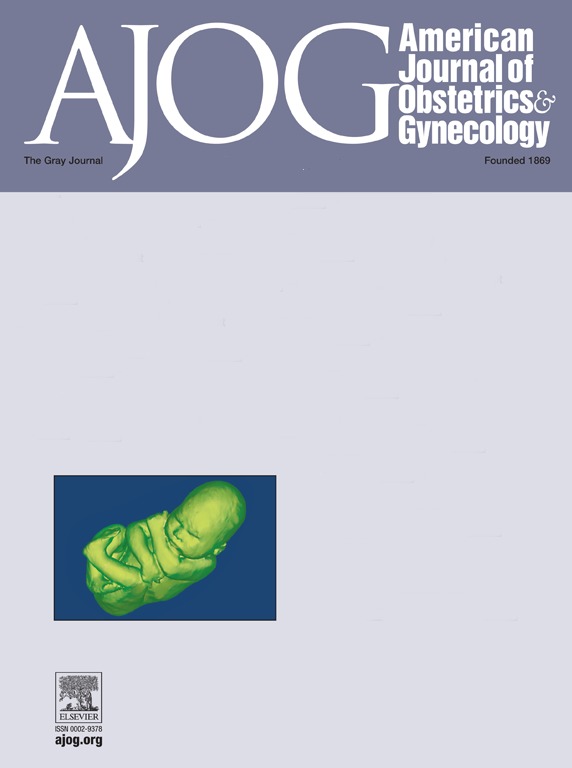超声筛查前置血管:系统回顾和荟萃分析。
IF 8.4
1区 医学
Q1 OBSTETRICS & GYNECOLOGY
引用次数: 0
摘要
目的评价采用标准化的妊娠中期超声筛查方案,并在妊娠晚期进行超声确认的研究中,前置血管(VP)的产前检测和围产儿生存率。数据来源pubmed /MEDLINE, Web of Science, EMBASE, Global Health和Global Index Medicus从成立到2024年2月16日进行检索。研究资格:我们纳入了实施标准化的妊娠中期超声方案的队列研究——无论是通用的还是有针对性的——用于副总裁筛查,在分娩时进行妊娠晚期超声确认和验证,至少持续一年。符合条件的研究报告了筛查的妊娠总数和确诊副总裁病例的数量。方案包括评估胎盘脐带插入,宫颈区域成像和经阴道彩色多普勒在高危患者。我们排除了仅孕早期筛查、病例报告、综述、会议摘要和重叠人群。研究评价和综合方法:两位审稿人独立筛选研究和提取数据,通过共识解决差异。使用QUADAS-2评估偏倚风险。采用R 4.4.0版本(R Core Team, 2024),采用反方差加权固定效应模型对敏感性、特异性和围产期生存率进行meta分析。采用χ 2、τ2和I2统计量评估异质性。敏感性分析排除了高偏倚风险的研究。采用漏斗图和Egger检验评价发表偏倚。结果在1817篇出版物中,19篇符合纳入标准,包括779,845例妊娠和505例VP病例(1,544例中有1例)。其中494例(97.8%)是产前诊断的。标准化的妊娠中期超声筛查的总敏感性-妊娠晚期确诊-为1.00 (95% CI: 0.99-1.00;I2 = 0%),特异性也为1.00 (95% CI: 1.00-1.00;I2 = 0%),基于774,937例怀孕和11例假阳性。产前诊断病例的围产期生存率为87.5% ~ 100%,总生存率为98.15% (95% CI: 88.30% ~ 100.00%;I2 = 0%)。在排除高偏倚风险的研究后,结果保持一致。未发现发表偏倚的证据。结论VP标准化筛查检出率高,围产期生存率高,假阳性和假阴性率低。这些发现为VP的标准化筛查提供了强有力的理由。本文章由计算机程序翻译,如有差异,请以英文原文为准。
Ultrasound Screening for Vasa Previa: A Systematic Review and Meta-Analysis.
OBJECTIVE
To evaluate the prenatal detection of vasa previa (VP) and perinatal survival in studies that implemented standardized protocols of prospective second-trimester ultrasound screening protocols followed by ultrasound confirmation in the third trimester.
DATA SOURCES
PubMed/MEDLINE, Web of Science, EMBASE, Global Health, and Global Index Medicus were searched from inception to February 16, 2024.
STUDY ELIGIBILITY
We included cohort studies that implemented standardized second-trimester ultrasound protocols - either universal or targeted - for VP screening, with third-trimester ultrasound confirmation and verification at delivery, over at least one year. Eligible studies reported both the total number of pregnancies screened and the number of confirmed VP cases. Protocols included assessment of placental cord insertion, cervical region imaging, and transvaginal color Doppler in at-risk patients. We excluded first-trimester-only screening, case reports, reviews, conference abstracts, and overlapping populations.
STUDY APPRAISAL AND SYNTHESIS METHODS
Two reviewers independently screened studies and extracted data, with discrepancies resolved by consensus. Risk of bias was assessed using QUADAS-2. Meta-analyses of sensitivity, specificity, and perinatal survival were conducted using fixed-effects models with inverse-variance weighting using R version 4.4.0 (R Core Team, 2024). Heterogeneity was assessed with chi-square, τ2, and I2 statistics. Sensitivity analyses excluded studies with high risk of bias. Publication bias was evaluated using funnel plots and Egger's test.
RESULTS
Of 1,817 publications, 19 met inclusion criteria, encompassing 779,845 pregnancies and 505 VP cases (1 in 1,544). Of these, 494 (97.8%) were diagnosed prenatally. The pooled sensitivity of standardized second-trimester ultrasound screening - with third-trimester confirmation - was 1.00 (95% CI: 0.99-1.00; I2 = 0%), and specificity was also 1.00 (95% CI: 1.00-1.00; I2 = 0%), based on 774,937 pregnancies and 11 false positives. Perinatal survival among prenatally diagnosed cases ranged from 87.5% to 100%, with a pooled survival rate of 98.15% (95% CI: 88.30%-100.00%; I2 = 0%). Results remained consistent after excluding studies at high risk of bias. No evidence of publication bias was found.
CONCLUSIONS
Standardized screening for VP is associated with a high detection rate and high perinatal survival, with minimal false-positive and false-negative rates. These findings make a strong case for standardized screening for VP.
求助全文
通过发布文献求助,成功后即可免费获取论文全文。
去求助
来源期刊
CiteScore
15.90
自引率
7.10%
发文量
2237
审稿时长
47 days
期刊介绍:
The American Journal of Obstetrics and Gynecology, known as "The Gray Journal," covers the entire spectrum of Obstetrics and Gynecology. It aims to publish original research (clinical and translational), reviews, opinions, video clips, podcasts, and interviews that contribute to understanding health and disease and have the potential to impact the practice of women's healthcare.
Focus Areas:
Diagnosis, Treatment, Prediction, and Prevention: The journal focuses on research related to the diagnosis, treatment, prediction, and prevention of obstetrical and gynecological disorders.
Biology of Reproduction: AJOG publishes work on the biology of reproduction, including studies on reproductive physiology and mechanisms of obstetrical and gynecological diseases.
Content Types:
Original Research: Clinical and translational research articles.
Reviews: Comprehensive reviews providing insights into various aspects of obstetrics and gynecology.
Opinions: Perspectives and opinions on important topics in the field.
Multimedia Content: Video clips, podcasts, and interviews.
Peer Review Process:
All submissions undergo a rigorous peer review process to ensure quality and relevance to the field of obstetrics and gynecology.

 求助内容:
求助内容: 应助结果提醒方式:
应助结果提醒方式:


